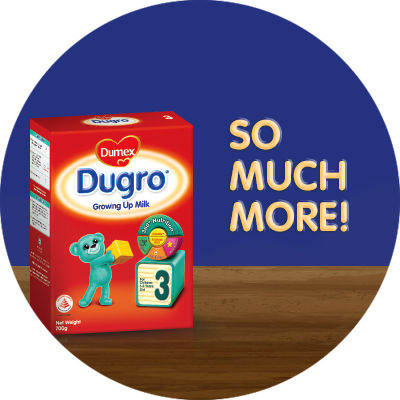Breastfeeding is the best for babies and a healthy diet / maternal nutrition is important when breastfeeding. A decision not to breastfeed can be difficult to reverse. Infant formula is suitable from birth when babies are not breastfed. It is recommended that all formula milks be used on the advice of a doctor, midwife, health visitor, public health nurse, dietitian, pharmacist, or other professional responsible for maternal and child care and the financial implications should be considered. All preparation and feeding instructions should be followed carefully as inappropriate preparation could lead to health hazards.
What Are The Terrible Twos & How To Deal With It
We have heard of the term ‘dynamic duo’ many times, but there is another term that every parent may dread hearing: the terrible twos. Researching these two words might give parents a clear indication as to what it is, but simply put, it is a period in a child’s social development during which they might exhibit signs of rebellious behaviour.
Why does the terrible twos phase happen, and is it normal?
It is absolutely normal. Both experienced parents and pediatricians are familiar with this term, so it is not a cause for alarm. This is just your toddler’s way of juggling his or her desire to seek independence but still placing heavy reliance on you. However, due to their limited vocabulary, they begin to feel frustrated. As such, the only way they can express themselves is through anger or aggression.
What are the signs of the terrible twos?
Examples of behaviour that warrants the term ‘terrible two’ include defiantly saying no, throwing tantrums and even confusing mood swings such as being clingy for a second and running off in a screaming rage the next2. Hence, the word ‘terrible’! Other signs include:
• Screaming
• Biting
• Kicking
• Throwing things
• Running away
• Sudden mood changes
• Temper tantrums
How can parents manage this phase?
When you begin to notice your child’s sudden mood changes and temper tantrums, it is helpful to remember that your child isn’t doing this purposely out of rebellion. That being said, do not fight fire with fire. When your child does begin yelling at you, do not respond in a similar fashion.
After all, responding to anger with anger may lead your child into believing that it is acceptable3. This is an important phase where parents can help their children develop their vocabulary so as to better deal with their emotions.
Remain calm and get your own emotions under control. While toddlers tend to throw tantrums in public areas, do remember to keep cool. Here are other ways you can manage these types of situations better:
• Try distracting your child. Divert his or her attention to something else nearby, especially at something they might like. For example, point at a random object in the distance. Otherwise, get them to participate in something such as getting or looking for a certain item.
• Under no circumstances should you ‘reward’ your child for this behaviour. It may be tempting to give them something they are demanding, but this sends the wrong message that their strategy is working. Conversely, do not resort to spanking as punishment.
• If distracting does not work, ignore their behaviour. Be consistent with this method, as your child will then begin to understand that such outbursts will not get the response they seek.
• If and when your child throws a tantrum in public spaces, bring them aside and patiently wait until they calm down. Be sure not to berate them for their behaviour but praise them if they do indeed relax and revert to good behaviour.
• Ensure that your child gets proper rest, or that the activities you have planned do not clash with their nap or meal times. Tired and hungry children will become cranky, and that will certainly elicit unwanted behaviour.
What are the common misconceptions about the terrible twos?
Here are myths about terrible twos that you should not pay mind to:
• It only lasts a year.
Keep in mind that while the term ‘terrible twos’ was named after the specific age, there are instances where this phase begins before the age of two. It can begin long before your child’s second birthday and last well past their third birthday. It will last for a certain period but will not carry on until mid-childhood.
• Your child just wants to test you and push you to your limits.
Your child’s brain isn’t developed enough to even consider this, and they can’t handle extreme emotions6. Just in case you were wondering if they were doing this on purpose, they’re not.
• They just want to destroy things.
While they do typically leave a path of destruction wherever they go during this time, it isn’t because they want to ruin things. It’s because they are at an extremely curious age and would like to touch and try everything.
Let Dumex Mamil Gold support you throughout the terrible twos phase
The terrible twos is a phase strongly associated with a child’s mood. How can parents alleviate their children’s mood? One way is by supporting a healthy gut system, of course!
Studies have shown that a healthy gut not only supports overall wellbeing and development, but it also influences mood.
To support a healthy gut, Dumex has introduced the Dumex Mamil Gold which is formulated with a unique prebiotic blend of galacto-oligosaccharides (GOS) and long-chain fructo-oligosaccharides (IcFOS) in a 9:1 ratio. However, that’s not all the goodness that Dumex Mamil Gold contains!
Made from a formula with naturally sourced milk that’s produced by free-roaming grass-fed cows, Dumex Mamil Gold is also formulated with more than 30 nutrients including DHA, calcium, vitamins D & E, and zinc. In line with Dumex’s Nature campaign for their Dumex Mamil Gold product range, rest assured that Dumex Mamil Gold is free from GMO, colourings and added sucrose.
Watch the terrible two phase fly by with Dumex. Find out more about Dumex Mamil Gold by visiting https://www.dumex.com.sg/. There are also free Dumex Mamil Gold product samples available.
References:
1. Hocker, J. (2019). "I've heard a lot about the terrible twos. Why are 2-year-olds so difficult?" Mayo Clinic. Retrieved on 30 June 2020, from https://www.mayoclinic.org/healthy-lifestyle/infant-and-toddler-health/expert-answers/terrible-twos/faq-20058314
2. Gill, K. (2019). What to Expect from the Terrible Twos. Healthline. Retrieved on 30 June 2020, from https://www.healthline.com/health/parenting/terrible-twos
3. Pincus, D. Calm Parenting: How to Get Control When Your Child is Making You Angry. Empowering Parents. Retrieved on 30 June 2020, from https://www.empoweringparents.com/article/calm-parenting-get-control-child-making-angry/
4. Iannelli, V. (2020). Toddlers and the Terrible Twos. Verywell Family. Retrieved on 30 June 2020 from https://www.verywellfamily.com/terrible-twos-and-your-toddler-2634394#citation-1
5. Gill, K. (2019). What to Expect from the Terrible Twos. Healthline. Retrieved on 30 June 2020, from https://www.healthline.com/health/parenting/terrible-twos
6. Onderko, P. (2011). Handling the Terrible Twos, Three, Fours. Parenting.com/CNN. Retrieved on 30 June 2020, from https://edition.cnn.com/2011/08/25/living/terrible-twos-myth-parenting/index.html?no-st=1539445331
7. Dealing with Toddlers. University of Illinois Extension. Retrieved on 30 June 2020, from https://web.extension.illinois.edu/toddlers/exploring.cfm
8. Huang, T.T, et al. (2019). Current Understanding of Gut Microbiota in Mood Disorders: An Update of Human Studies. Zhejiang University School of Medicine. Retrieved on 30 June, 2020 from https://www.ncbi.nlm.nih.gov/pmc/articles/PMC6389720/


Ask Our Careline
Whatever’s on your mind, we’re here to help




